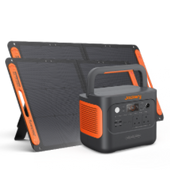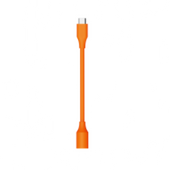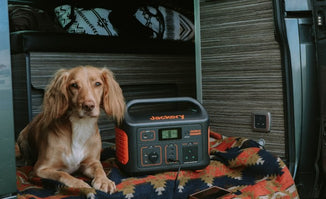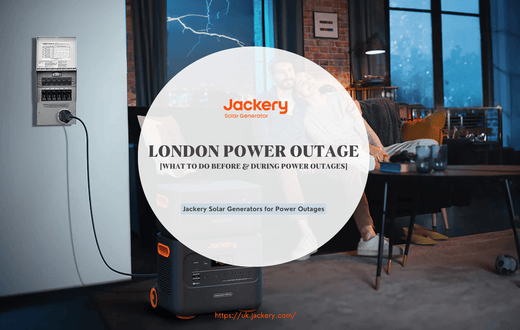Although power outages are uncommon, when they occur, especially at night or during extreme weather conditions, they can cause inconvenience and safety concerns. Power outages affect all aspects of modern society, from daily life to the operation of critical infrastructure.
By preparing in advance and taking proactive actions, you can ensure safety, comfort and peace of mind during a power outage. This guide summarises power outages in London, what to prepare for before, what to do during, and how to report one.
Moreover, a sudden power outage may cause accidents or further damage in an emergency, so having a generator to keep your home or company working continually is essential. We highly recommend Jackery Portable Power Station, a portable backup power solution, to charge your appliances in power outages or emergencies.
|
Key Takeaways: |
|
- London's power outages in recent years have seriously impacted citizens' lives. - In London, you can check for a power outage in your area with a few simple steps. UK Power Networks' power outage checker makes it easy to determine if there is a power outage in your area. Or you can call 105 to report a power outage. - The reasons for power outages in London are multifaceted and involve many aspects, such as natural disasters, ageing power infrastructures, power damage surges, or human error. - A practical power outage survival kit can ensure you stay safe during a power outage. - Having a Jackery Explorer 1000 v2 or 2000 Plus may help you survive a power outage in London by charging your essential appliances. |
London Power Outage Facts
Power outages in the UK can be planned or unplanned. However, extreme weather events like storms, floods, or heavy snow can cause more extended power outages. London has suffered several large-scale power outages in recent years, seriously impacting urban transportation, economic activities, and citizens' lives.
On August 9, 2019, a large-scale power outage occurred in London and southeast England. Two generators reportedly failed, causing the power system frequency to drop. Although the power supply was restored quickly, the impact on urban transportation and people's lives lasted several hours.
On March 11, 2024, parts of central London suddenly lost power, affecting at least 150 buildings, including restaurants, theatres and residential buildings. The power outage was attributed to a cable failure in the city centre, which plunged tourist-dense areas such as the West End and Soho into darkness.
In recent years, power outages in London have caused great inconvenience to Londoners and dealt a heavy blow to the city's economy. During the power outage, the subway stopped operating, and trains were delayed, stranding many commuters and creating traffic chaos. At the same time, power outages in commercial areas forced businesses to close early and entertainment activities to be cancelled, causing substantial economic losses.
How Do You Check If There Is a Power Outage in London?
In London, power outages are usually caused by planned and unplanned outages. The local distribution network operator arranges planned outages to carry out essential maintenance. Unplanned outages are typically caused by unforeseen circumstances such as extreme weather.
Sometimes, when electricity demand exceeds supply, emergency planned outages or rolling load shedding are implemented to protect the integrity of the power system. So, how can you check if there is a power outage in your area in London?
Check If a Power Outage Has Occurred
Before contacting your local distribution network operator (DNO), follow these few simple steps to confirm your local power outage:
- Use the power outage check map (londonhydro.com), updated in real-time, to see if there is a power outage in your area.
- Check with neighbours to see if the power outage is happening to the whole block (or just your house).
- Check inside your house's fuse box to see if the fuse is blown.
- Call 105 or visit their website.
You can call 105 or visit their website (https://www.powercut105.com/en/) to get the latest news on power outages in London. Alternatively, you can call 105 to be connected to your DNO.
Contact your Distribution Network Operator
Electricity suppliers sell energy to consumers and are not responsible for the power lines that connect your home or business to the national grid. Instead, the Distribution Network Operator (DNO) is responsible for maintaining the power lines that connect your home or business to the grid.
Each area has a dedicated Distribution Network Operator, whom you can call directly using the contact information below. Alternatively, you can check the power outages on the Operator's website.
How do I check the relevant Distribution Network Operator (DNO)?
If you want to find your local Distribution Network Operator (DNO) more efficiently, enter your postcode on the Energy Networks Association website to find your DNO.
UK Power Networks' power outage checker makes it easy to determine if there is a power outage in your area. Enter your postcode on the page to view real-time power information for your area. How to contact UK Power Networks:
Customer service hotline: 0800 3163 105
Web: www.ukpowernetworks.co.uk
How Do You Report a Power Outage in London?
The first thing to do after confirming a power outage is to report the outage to your electricity supplier. Once you notice an unexpected power outage, report it as follows:
- Call 105
- Contact the Distribution Network Operator (DNO)

How Do Power Outages Usually Happen?
The stability of London's power system is directly related to residents' lives and economic development. The reasons for London's power outages are multifaceted, involving ageing infrastructure, natural disasters, human errors, and other factors.
Natural Disasters
Natural disasters are also essential factors in London's power outage. In the UK, most unexpected power outages are caused by severe weather. On August 9, 2024, a large-scale power outage caused by lightning strikes in London and surrounding areas affected 1 million users.
Power Demand Surges
During peak usage, the power grid may be overloaded, resulting in temporary power outages. For example, in July 2024, a large-scale power outage occurred in central London due to a sharp increase in electricity demand caused by high-temperature weather. Similarly, in winter, most people will also increase their demand for electricity due to cold weather.
Ageing Power Infrastructure
Transformers, circuit breakers or other electrical equipment often fail due to age, causing power outages. Some of London's power system facilities are relatively old and have not been updated, resulting in system overloads or failures during peak power consumption.
Human Error
Operational errors and technical failures are also factors that cannot be ignored. Cables can be damaged during construction, building projects, or even when people dig in their gardens. For example, in August 2023, a large-scale power outage in London was caused by workers mistakenly installing incorrectly specified fuses, causing the power system's automatic protection device to malfunction and cut off the power supply.
How to Prepare for a Power Outage in London?
Power outages can be a hassle, whether caused by natural disasters, line failures or planned brownouts. Many people must be prepared to stay safe during power outages in London. Here are some tips to help you prepare for a power outage:

Step 1: Get Power Outage Information
Follow your power supplier's outage map to monitor for constant information about power outages. Alternatively, you can follow local news and social media for the latest outage information and estimated restoration times. Stay in touch with your neighbours to share information and resources to help each other in emergencies.
Step 2: Make an Emergency Plan
An emergency plan is crucial for many families to prepare for power outages. And getting your family involved in your emergency preparedness plan can make a big difference. Ensure all family members know the power outage plan and have a clear action plan during a power outage, especially for older people and children. You can also conduct regular drills to familiarise everyone with emergency procedures.
Step 3: Power Protection
If you know the specific time of the power outage, turn off the plugs of electrical appliances susceptible to power surges before the outage, especially high-power appliances such as electric heaters and electric stoves, to prevent fires when the power comes back on.
Consider using a power protector or voltage stabiliser to protect electronic devices from voltage fluctuations. Consider using an uninterruptible power supply (UPS) system for essential devices like computers and routers.
Step 4: Prepare for Different Seasons
Summer power outages can cause heat-related illnesses, so stock up on cooling supplies such as fans and battery-powered air conditioners. Also, make sure you have plenty of bottled water.
During colder seasons, power outages may last longer due to weather conditions, so prepare warm clothing, blankets, etc., in advance. Insulating your home can prevent heat loss. If the power outage is extended, consider using a gas heater, but be safe.
Step 5: Plan Your Medication
After making basic power outage preparations, you also need to consider whether your family members have special needs that need to be met. For example, emergency preparations will be required if a family member needs medical care. Here are some additional things that family members who need medical care need to prepare in the event of a power outage:
- Stock up at least two weeks of medication in advance.
- If your family members rely on electricity for medical treatment, you should register their dependence on the electricity supplier.
- Make sure you have backup power in case the medical equipment you use fails due to a power outage.
A lot of our gadgets, like CPAP machines, home ventilators, and continuous oxygen monitors, need to be charged with energy. Because of this, preparing your home medical device to keep treating you even if the power goes out is essential.
|
Medical Devices |
Amps |
Hours |
Power Needed |
|
CPAP Machine |
55A |
8H |
440Ah |
|
Home Ventilator |
2.6A |
8H |
20.8Ah |
|
Oxygen Monitor |
1A |
12H |
12Ah |
|
Blood Pressure Meter |
0.5A |
0.2H |
0.1Ah |
First, you need to know everything about your home medical gadget. You must also know the details to get your supplies again and place another order.
After gathering your home medical device's details, examine how a power outage can affect it. Then, you can consider investing in a portable power supply, like Jackery Explorer 1000 v2 or 2000 Plus, to charge your medical devices safely at home.
Jackery Portable Power Stations for Power Outages
A portable power station is essential during a power outage as it serves as a backup electricity source. It enables individuals to use vital appliances and sustain fundamental operations in their homes or businesses when the primary power grid fails, especially in instances where outages may persist for prolonged durations due to natural disasters or other disruptions.

Jackery Portable Power Stations are the most practical power supply during London power outages. They are powerful, portable, and easy to use. The only thing you need to do is connect your appliances to the power station, and the electricity is back again.
Jackery Explorer 1000 v2
The Explorer 1000 v2 Portable Power Station provides an impressive 1500W output, 50% greater than earlier models, efficiently charging high-demand devices such as refrigerators, TVs, and portable ACs. Equipped with USB-A/C connections and dual PD charging up to 100W, it can simultaneously charge several devices (phone, laptop), rendering it the ideal companion for power outages or other emergencies.
The Emergency Charge Mode, activated via the app, enables the Explorer 1000 v2 Portable Power Station to achieve a full charge in under one hour, providing essential power backup when the battery is depleted. Moreover, charging from 0% to 100% within two hours via an AC wall outlet prolongs battery longevity.
Experience serenity with its nearly silent operation, maintaining noise levels below 22dB while energising your devices. This power station allows you to charge appliances with high capacity and safety and ensures no noise and pollutants when used at home or work.

|
*Review from Our User |
|
First, this item is robust and space-efficient, fitting seamlessly in my workspace (see pic). When the power goes out, it becomes a real game changer. I can continue my tasks as if everything is normal, which is quite impressive. The most advantageous aspect for me? The USB-C ports. I can connect my Mac directly to it without needing an adapter. Incredibly useful! |
Jackery Explorer 2000 Plus
Jackery Explorer 2000 Plus is the big breakthrough in portable power station technology. It uses the LiFePO4 battery inside to realise the expandable capacity, and you can have 2 to 12 kWh of electricity to charge essential appliances in a blackout.
The Jackery Explorer 2000 Plus has a remarkable output of 3000W, providing a 30% higher rated power than other 2 kWh solar products. Almost all necessary household appliances are powered.
ChargeShield is Jackery's advanced fast charge technology, featuring 62 protective mechanisms, 12 protective algorithms, and four types of physical safety protection.
This technology uses a unique stepped variable-speed charging algorithm to enhance safety and extend battery pack lifespan by 50%. Furthermore, it is easy to recharge Explorer 2000 Plus with SolarSaga 200W solar panels (2 hours), wall outlet (1.7 hours), and carport (25 hours).

|
*Review from Our User |
|
I have been using Jackery batteries for a long time. I felt great excitement upon the release of the Explorer 2000 Plus, which marks the inaugural release of an expendable battery system by Jackery. The system supports a capacity of up to 12kWh with a 3000W 120V output or 24kWh with a 6000W 240V output—an ideal enhancement for my home backup system. |
How To Make a Power Outage Survival Kit?
Power outages are expected due to power failures, extreme weather or planned maintenance work. A power outage survival kit can ensure you stay safe during a power outage. Here are some tips on how to make a practical power outage survival kit.

- Lighting Tools
Usually, the most essential tool in a practical power outage survival kit is lighting equipment.
Flashlight and spare batteries: Choose a high-intensity flashlight with high brightness and long battery life, and ensure enough spare batteries.
Candles and waterproof matches/lighters: Pay attention to fire safety for simple lighting and heating.
Battery-powered table lamp or emergency light: Ensure a stable light source.
- Communication Tools
Ensure the power outage survival kit includes a communication tool for communicating with the outside world during the power outage.
Radio: A battery-powered radio can receive emergency broadcasts and the latest information.
Walkie-talkie: Used for communication between family members when the mobile phone signal is poor or unavailable.
Satellite phone: An essential tool for contacting the outside world in extreme situations.
- Daily Necessities
Daily necessities, including food and personal items, must be prepared in case of an extended power outage.
Food: Please stock up on non-perishable food and drinking water, such as canned goods and compressed biscuits.
Bottled water: Stock up on enough drinking water to cope with the interruption of tap water supply.
Personal hygiene products: Please prepare essential products, including wet wipes, toilet paper, etc.
- Medical Supplies
Some accidents may occur during the power outage, so please prepare some standard medical supplies just in case.
Commonly used medicines: Please prepare basic medical supplies, including painkillers, anti-inflammatory drugs, band-aids, etc.
First aid supplies: Please prepare first aid supplies, including gauze, bandages, scissors, disinfectant, etc.
- Other Tools
In addition to the items mentioned above, some tools that may be used need to be prepared.
Fire extinguisher: Power outages may increase the use of open flames, so prepare a fire extinguisher just in case.
Multi-function knives: Knives with multiple functions can play an important role in emergencies, such as cutting ropes and opening cans.
Cash: ATMs and POS machines may not work during a power outage, so keep some money in case of emergency.
Essential documents: Put crucial documents, such as ID cards, household registration books, insurance policies, etc., in the survival bag so that they can be quickly retrieved in an emergency.
|
Power Outage Survival Kit List |
|
|
Lighting Tools |
Flashlight and spare batteries Candles and waterproof matches/lighters Battery-powered desk lamp or emergency light |
|
Communication Tools |
Radio Intercom Satellite phone |
|
Daily Necessities |
Food Bottled water Personal hygiene products |
|
Medical Supplies |
Commonly used medicines (painkillers, anti-inflammatory drugs, Band-Aids) First aid supplies (including gauze, bandages, scissors, disinfectant) |
|
Other Tools |
Fire extinguisher Multi-purpose knife Cash Important documents |
What To Do During a London Power Outage?
Power outages are common in London. Therefore, it is vital to take some measures to maintain daily life during one. Knowing what to do during a power outage will help Londoners cope with emergencies and ensure safety.
Step 1: Stay Calm
When a power outage occurs, the first thing to do is not to panic. Then, please quickly assess the scope and possible causes of the power outage. If only individual residents lose power, it may be a local problem. If the entire neighbourhood or region loses energy, it may be a more significant problem.
Step 2: Turn Off All Electrical Appliances
During a power outage, turn off the power switches of all electrical devices as much as possible, especially those in use. It will prevent the current surge that may occur when the power is restored, causing damage to the appliances.
Step 3: Keep the Refrigerator and Freezer Closed
During a power outage, keep the refrigerator and freezer doors closed and put ice cubes inside to keep food cold as much as possible. Open the refrigerator door only when necessary. In addition, the power outage time should be recorded to estimate whether the food is safe. If the power outage is likely to last more than 2 hours, consider putting perishable foods in the refrigerator and putting ice cubes in it.
Step 4: Safety Precautions
Power outages may cause problems such as elevator outages and safety system failures. Therefore, avoid using the elevator during a power outage and ensure your home's doors and windows are safe. If you must go out, pay attention to your surroundings to prevent accidents due to poor visibility.
Step 5: Entertainment and Relaxation
Usually, during a power outage, try to gather everyone in the most comfortable place in your home. In addition, you can use this opportunity to do some activities that do not require electricity, such as reading books, playing board games, chatting, etc. Interact with family or friends to enhance your relationship.
Step 6: Safe Use of Backup Power
Be careful when using backup power to directly power appliances during a power outage. Never connect more or larger appliances to the backup power supply; otherwise, it may cause safety hazards. Always ensure good ventilation to avoid carbon monoxide poisoning when using a gas generator. It is recommended to use an environmentally friendly solar portable power station during a power outage.
London Power Outages FAQs
The following are the frequently asked questions about the power outages in London:
- Are we going to have blackouts in the UK?
The UK has recently faced severe energy supply challenges and may face frequent power outages. The National Grid has repeatedly warned that homes and businesses may face a greater risk of power outages. In addition, power outages are particularly prominent in winter, when electricity demand peaks.
In general, the risk of power outages in the UK remains. However, future power outages in the UK will depend on the combined effect of multiple internal and external factors.
- Why is the UK having power outages?
In the UK, power outages will depend on various factors.
|
Power Outage Causes in the UK |
|
|
Gas Supply Shortage |
The UK relies heavily on gas for power generation, which accounts for more than 40% of the country's electricity. If the gas supply is insufficient, it will directly lead to power shortages, which may cause power outages. |
|
Limited Power Imports |
The UK relies on imports for some of its electricity. If other countries face energy shortages, the UK will need more power from them. |
|
Domestic Energy Facility Issues |
Some energy facilities in the UK are also facing challenges, such as decommissioning nuclear reactors and closing gas power plants due to price issues, further weakening the domestic power supply capacity. |
- Has there ever been a blackout in London?
London has experienced many power outages, some of which have profoundly impacted urban transportation and residents' lives. On August 9, 2024, London suffered another large-scale power outage, greatly inconveniencing citizens' lives and work. The power outages in London revealed the vulnerability of the city's power system in emergencies and prompted relevant departments to improve and strengthen power facilities.
Final Thoughts
Power outages can be frequent across London during the winter due to bad weather or possible power supply issues. Most of the time, your electricity supplier will notify you in advance of planned outages in your area and even let you know when power will be restored. However, London power outages can happen unexpectedly and disrupt daily life. It's essential to take precautions during a power outage, whether due to bad weather, equipment failure, or other factors.


































































































